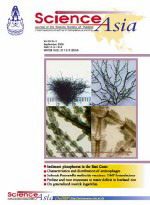ThaiScience
ThaiScience
SCIENCE ASIA
Volume 46, No. 03, Month JUNE, Year 2020, Pages 344 - 352
A colorimetric-based bioreporter for rapid genotoxicity monitoring using escherichia coli
Naruemon Chumjai, Alisa S. Vangnai
Abstract Download PDF
Environmental contamination of genotoxic agents has been a concern due to their ability to cause cellular DNA damages or cancer. In this work, the bioreporter PrecAlacZ was constructed based on Escherichia coli by fusing a promoter of a DNA damage response gene (recA) to a -galactosidase reporter gene (lacZ), which is called E. coli-recA bioreporter (EREC). For a reliable measurement, a level of the genotoxicity was normalized by bacterial cell respiration. Well-known genotoxic agents including sodium azide, 4-nitroquinoline 1-oxide and benzene were individually exposed to EREC in comparison with Ames test and commercial SOS-Chromotest™. The EREC was able to detect the genotoxic levels of all tested genotoxic agents, i.e. at 5, 31 and 1563 mg/L for sodium azide, 4-nitroquinoline 1-oxide and benzene, respectively, while the other two tests were unable to detect the genotoxicity of benzene even at lethal concentrations. A practical platform of genotoxic level detection was further developed based on EREC as freeze-dried cells on a microtiter plate. The freeze-dried EREC, kept at 20 °C for three months, was able to maintain cell survival of more than 97% and genotoxic sensitivity comparable to that of the freshly prepared cells. The freeze-dried EREC was also able to detect the genotoxicity of representative environmental-polluted pesticides including Chlorpyrifos, Profenofos and Cypermethrin at 25, 100 and 100 mg/L, respectively, and at the maximum residue limits permitted in agriculture commodity of pesticide mixtures thereof. In conclusion, the EREC can be further applied as a high-throughput genotoxicity screening of environmental pollutants either as individuals or combinations thereof.
Keywords
bioreporter, freeze-dried bacteria, Escherichia coli, genotoxicity, pesticideSCIENCE ASIA
Published by : The Science Society of Thailand
Contributions welcome at : http://www.scienceasia.org/
